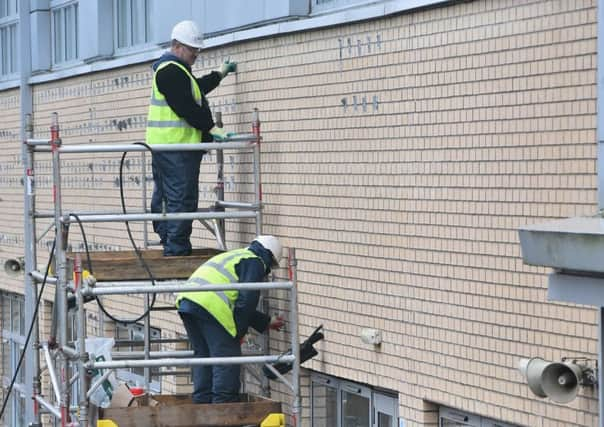Martyn McLaughlin: Blame game starts in Edinburgh schools scandal


Every so often, a stramash behind the curtains has threatened to expose the illusion of public private partnership contracts, a ruinous ideology which, for a generation, became political doctrine. The scandal of the Edinburgh PPP1 project throws them wide open, revealing a scathing example of the grand conjuring trick that allows global consortia to make handsome profits at taxpayers’ expense.
It is a deal devised around secrecy and inflexibility, relegating issues such as the quality and integrity of the public infrastructure to the periphery. Such is the gamble the City of Edinburgh Council took, prioritising short-term gain at the cost of paralysing long-term expense and risk.
Advertisement
Hide AdAdvertisement
Hide AdThe aftermath has prompted an all-too-familiar blame game, with various parties looking to gain political advantage from the crisis. In 2016 Scotland, we should not be surprised. Yet their time would be best spent scrutinising the intricacies of the PPP1 arrangement and ensuring every last detail is disclosed to the public in a comprehensive inquiry in the next parliamentary term.
The first question that must be answered is paramount: who is ultimately responsible for the defects in the schools? The focus so far has been on Miller Construction, a firm purchased by Galliford Try in 2014. Galliford confirmed yesterday it assumed “contractual responsibility” for four of the 17 schools closed. But will the safety inspections be carried out at every school and, if further faults emerge, was Miller the only contractor involved?
A look through the full PPP1 business case suggests that is unlikely. It identifies no fewer than seven firms involved in construction work, with seven other companies serving as professional advisers and a further two providing expertise in design and planning.
The process of untangling this fraternity to ascertain who built what is no doubt complicated, but such is the scale of the scandal, the old commercial confidentiality arguments against disclosure no longer apply.
The full business case, the only substantive PPP1 document in the public domain, is short on detail as to the frequency and diligence of building standards checks, but notes that if failings are not solved within a “rectification period,” the council can make deductions from its unitary payments.
Which brings us to questions two and three: what steps will the council take to claw back money from the Edinburgh Schools Partnership (ESP), the special purpose vehicle that built, runs and owns the schools? And does the deal safeguard the council for compensation claims and potential legal action?
Whatever provisions are in place, they too should be made public. After all, these schools are eye-wateringly expensive. The unitary charge payment for the current financial year is £17.5m, a fraction of the overall cost, currently projected at £531.8m. All this for an estate with a capital value of £129m.
Questions three and four return to the minutiae of the business case, namely section 7.8.6, which stipulates that the council has “the right to step in and perform (or procure a third party to perform) ESP’s obligations under the contract where a serious risk to health, safety, property or the environment exists, or where the council is required to discharge a statutory duty.”
Advertisement
Hide AdAdvertisement
Hide AdGiven the disruption caused so far, does the local authority intend to exercise this right? If not, will it renegotiate the remainder of its 30-year contract with ESP to put in place more stringent conditions?
The fifth question is perhaps the most obvious. Why did it take more than a decade for these faults to be identified?
Back in May 2004, when formulating PPP2, the next stage of its schools programme, the council noted in its revised outline business case that “following feedback from PPP1, it is the council’s intention to develop the output specification and evaluation criteria to ensure that a greater emphasis is placed on wider aspects of school building design for PPP2 such as supporting inclusion, future flexibility and the architectural integrity of the buildings.” This is a conveniently vague paragraph, but its implication is clear; concerns were raised about the design and build of the first tranche of schools 12 years ago.
ESP has said it will take “full financial responsibility” for investigating and resolving remedial work. Quite right, too, for it can well afford it. Since 2007, it has made profits in excess of £17m, much of which has gone offshore.
A cursory look through the accounts of ESP (Holdings) Ltd, the company that controls the partnership’s equity, details snappily named shareholders: Palio (No 19) Limited; Aberdeen Infrastructure (No 3) Limited; PFI Infrastructure Finance Limited; and Semperian PPP Investment Partners No 2 Limited.
Palio (No 19) is owned by JLIF (GP) Limited, a wholly owned subsidiary of the Luxembourg registered JLIF Luxco 1 S.à.r.l. Semperian is ultimately controlled by a Jersey-based fund, while PFI Infrastructure Finance is part of BIIF LP, owned by venture capital company, 3i, which has a major investment firm registered in Jersey.
No doubt these fine corporate vehicles deliver favourable returns for their faceless investors, but they give rise to a sixth question, arguably the most important of the lot.
Is the integrity of Edinburgh’s school estate and the welfare of the city’s pupils their chief priority?
That query, in case you hadn’t already guessed, is purely rhetorical.